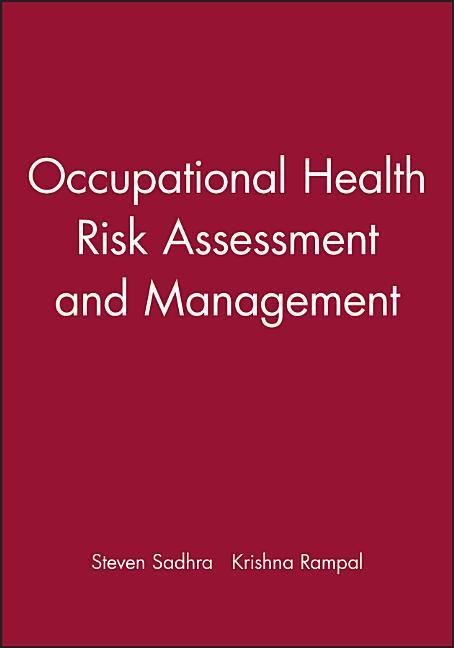
Zustellung: Di, 05.08. - Mo, 11.08.
Versand in 3-4 Wochen
VersandkostenfreiBestellen & in Filiale abholen:
This book provides the theory and the practice of risk assessment and management in the context of hazardous substances in the workplace based on a rational conceptual framework. Exposure to chemicals in industry and commerce is particulary important given the volume of chemicals used, the different forms in which they may exist and their range of health effects. This book will address the historical perspectives; discuss the various models available, propose a more comprehensive model and discuss the various elements of risk assessment and the management process. Furthermore applications of risk assessment and management in various industrial sectors will be discussed based either on substance or the process involved. This book will link the theory with the practice of risk assessment and management. It will provide the individual responsible, as well as those involved in providing input into the process of risk assessment and management in the workplace a clear understanding of the issues and the activities involved. It will also provide examples of assessment and management in a range of selected industries and processes.
Inhaltsverzeichnis
List of contributors. Foreword.
Section 1 Introduction.
Chapter 1 Basic concepts and developments in health risk assessment and management.
Chapter 2 Organizing for risk assessment and management.
Section 2 Risk assessment.
Chapter 3 Toxicological basis of hazard identification.
Chapter 4 Epidemiological basis of hazard identification.
Chapter 5 Occupational hazard types and their characteristics.
Chapter 6 Hazard identification techniques.
Chapter 7 Standard setting in occupational health.
Chapter 8 Requirements of monitoring exposure to workplace contaminants.
Chapter 9 Exposure modelling.
Chapter 10 Risk characterization.
Section 3 Risk management.
Chapter 11 Prevention and control of exposures.
Chapter 12 Economics of risk management.
Chapter 13 Emergency response.
Chapter 14 Risk perception.
Chapter 15 Risk communication.
Chapter 16 Health surveillance.
Chapter 17 Auditing risk assessment and management.
Chapter 18 Demonstrating compliance with the law.
Section 4 Applications of risk assessment and management in industry: case studies.
Chapter 19 Agriculture (pesticides).
Chapter 20 Assessment of exposure to isocyanates.
Chapter 21 Vibration.
Chapter 22 Risk management and manual handling.
Chapter 23 Risk management and display screen equipment.
Chapter 24 Biological agents.
Chapter 25 Risk assessment and management of asbestos in Malaysian industry.
Chapter 26 Risk assessment for workers exposed to ionizing radiation.
Chapter 27 Stress.
Chapter 28 Violence at work.
Appendix 1 Examples of UK legislation for different occupational hazard types.
Appendix 2 Schedule 3 to RIDDOR 1995.
Appendix 3 Information sources for the assessment and management of occupational health hazards.
Index.
Section 1 Introduction.
Chapter 1 Basic concepts and developments in health risk assessment and management.
Chapter 2 Organizing for risk assessment and management.
Section 2 Risk assessment.
Chapter 3 Toxicological basis of hazard identification.
Chapter 4 Epidemiological basis of hazard identification.
Chapter 5 Occupational hazard types and their characteristics.
Chapter 6 Hazard identification techniques.
Chapter 7 Standard setting in occupational health.
Chapter 8 Requirements of monitoring exposure to workplace contaminants.
Chapter 9 Exposure modelling.
Chapter 10 Risk characterization.
Section 3 Risk management.
Chapter 11 Prevention and control of exposures.
Chapter 12 Economics of risk management.
Chapter 13 Emergency response.
Chapter 14 Risk perception.
Chapter 15 Risk communication.
Chapter 16 Health surveillance.
Chapter 17 Auditing risk assessment and management.
Chapter 18 Demonstrating compliance with the law.
Section 4 Applications of risk assessment and management in industry: case studies.
Chapter 19 Agriculture (pesticides).
Chapter 20 Assessment of exposure to isocyanates.
Chapter 21 Vibration.
Chapter 22 Risk management and manual handling.
Chapter 23 Risk management and display screen equipment.
Chapter 24 Biological agents.
Chapter 25 Risk assessment and management of asbestos in Malaysian industry.
Chapter 26 Risk assessment for workers exposed to ionizing radiation.
Chapter 27 Stress.
Chapter 28 Violence at work.
Appendix 1 Examples of UK legislation for different occupational hazard types.
Appendix 2 Schedule 3 to RIDDOR 1995.
Appendix 3 Information sources for the assessment and management of occupational health hazards.
Index.
Produktdetails
Erscheinungsdatum
15. April 1999
Sprache
englisch
Seitenanzahl
504
Autor/Autorin
Steven S Sadhra, Krishna G Rampal
Verlag/Hersteller
Produktart
gebunden
Gewicht
1233 g
Größe (L/B/H)
252/177/32 mm
ISBN
9780632041992
Entdecken Sie mehr
Bewertungen
0 Bewertungen
Es wurden noch keine Bewertungen abgegeben. Schreiben Sie die erste Bewertung zu "Occupational Health" und helfen Sie damit anderen bei der Kaufentscheidung.









